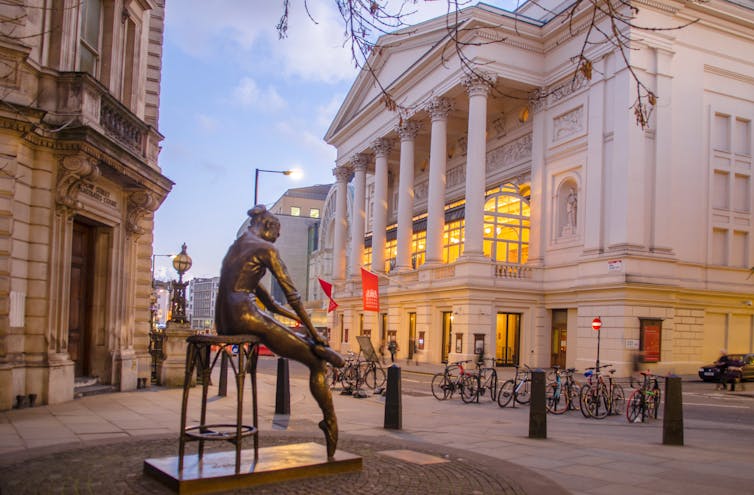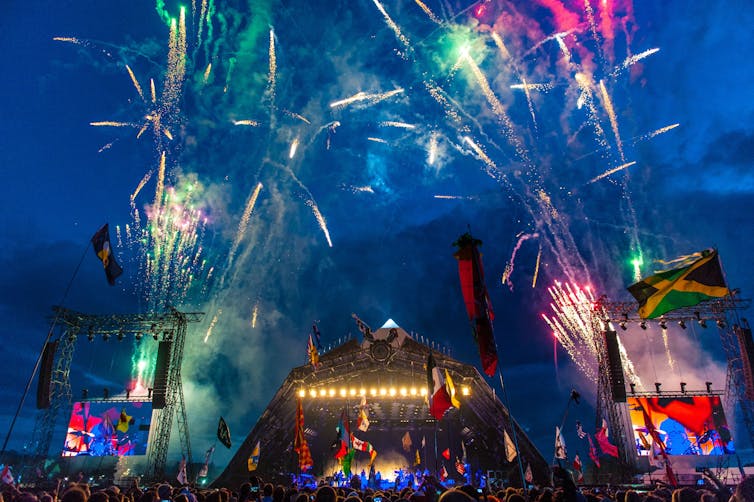 |
| Closed for the duration: the Royal Opera House, London. (Willy Barton via Shutterstock) |
There’s still a great deal of uncertainty as to what impact the coronavirus pandemic will have on the UK’s cultural life. More and more people are now choosing to self-isolate and theatres, cinemas, clubs and concert halls are closing down for the duration with talk that an enforced lockdown is ever more imminent.
While initially presented as voluntary, cancellations of performances, conferences and other events were formalised on March 16 by the UK’s prime minister, Boris Johnson. Johnson advised citizens to “avoid pubs, clubs, theatres and other such social venues” as part of a larger strategy to suppress the spread of coronavirus. People working in the arts sector are understandably concerned about what this might mean for the UK’s diverse community of artists and performers – as well as all those in the sector who support those performers.
The government has introduced some measures that aim to support the arts sector, both at a local and a national level. But a number of artists are trying to find ways to work from home by livestreaming their performances online. Such a shift forces artists to consider technological, economic and aesthetic issues – and may signal the dawning of a new era in live performance.
Have broadband, will perform
The livestreaming of artistic performances is not new – but until now the practice has not been a significant alternative to the live music economy at large. Perhaps the most common form of livestreaming has been through videos taken at gigs or festivals by audience members who want to share their experience of the live performance via footage shot on their smartphones.But there have also been concentrated efforts by venues and artists to reach online audiences. A number of well-established organisations such as the Wigmore Hall and the Royal Shakespeare Company regularly complement existing performance series with livestreaming to reach wider audiences or as educational outreach.
Virtual gigs
The vast amount of livestreaming that takes place in the arts sector is in parallel with (or contingent upon) face-to-face performance. There are signs that this is already changing as social restrictions around the coronavirus pandemic become more widespread.In the US, Rolling Stone magazine has highlighted how larger bands and venues are working to quickly provide online alternatives to gigs and tours that have now been cancelled due to lockdowns.
The move towards online live performance is even attracting artists who might not be thought of as natural users of digital technology. As many New York City venues were closed in the week preceding St Patrick’s Day, musicians involved in the Irish trad scene formed Tune Supply – a platform by which they could provide “customised traditional music and dance performance and instruction delivered digitally for the socially distanced world”.
As livestreaming concerts has historically been used to complement or advertise existing live events, the void left by the cancellation or indefinite postponement of these events forces online alternatives into greater importance. This shift in performance practice has logistical, financial, and artistic implications.
We have the technology
The infrastructure needed to livestream performances is readily available through consumer-level products. Modern smartphones are more than capable of generating high-definition videos, and the software needed to record and edit sound – something that was once the preserve of professional recording studios – has become relatively commonplace.There’s obviously something of a learning curve involved in using this software adeptly, but there is a wealth of online resources for musicians to become more proficient producers. But beyond actually organising the performance, artists need to be able to ensure they have adequate bandwidth to transmit that performance to audiences. With increasing access to high-speed internet, the stage is set for potential viewers to access content with minimal lag and disruption.
Who’s making all the money?
Financially, artists will have to determine how they monetise these performances. Several models already exist to do so, each with unique features. Platforms such as YouTube allow artists to livestream performances and upload other videos, with income being generated through ad revenue. The amount of profit relies heavily on the amount of advertising and number of viewers – videos under ten minutes make, on average, about US$2.00 (£1.70) for every 1,000 views.Twitch, on the other hand, works on a subscription basis – audiences pay set fees to access broadcasts of events. At the moment, this platform caters more towards professional online gaming, but there are also communities around the performing arts as well. Patreon also works on a subscription basis, but is more closely tied to crowdfunding. Generating work through the financial support of their audiences, artists often benefit from establishing positive relationships with them.
That ‘live’ feeling
Beyond the technological and financial logistics of livestreaming performances is a greater aesthetic issue. Livestreaming technically provides all of the ingredients to allow live music to persist in an era of social distancing. Artists can still provide high-quality audio and visual experiences to their audiences and audiences can still enjoy new music or their favourite hits, all without leaving their comfort of their own homes. |
| Glastonbury Festival has been cancelled, despite it being the 50th year. (marietta peros via Shutterstock). |
As increasing numbers of musicians and audiences adopt this way of making and enjoying music together, I suspect all participants will develop a new set of expectations around where aesthetic value is placed in the performance.
This unprecedented global crisis provides an opportunity for artists to develop new ways of working with audiences and content to replicate that sense of “liveness” and connectivity found in a concert hall. Who knows? This might become an enduring part of a new reality.

About Today's Contributor:
J Murphy McCaleb, Senior Lecturer of Music, York St John University
This article is republished from The Conversation under a Creative Commons license.


















